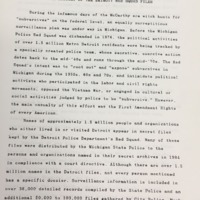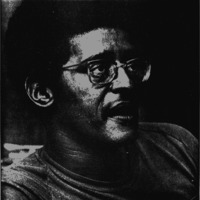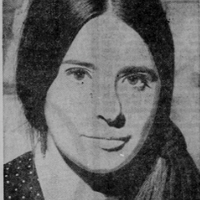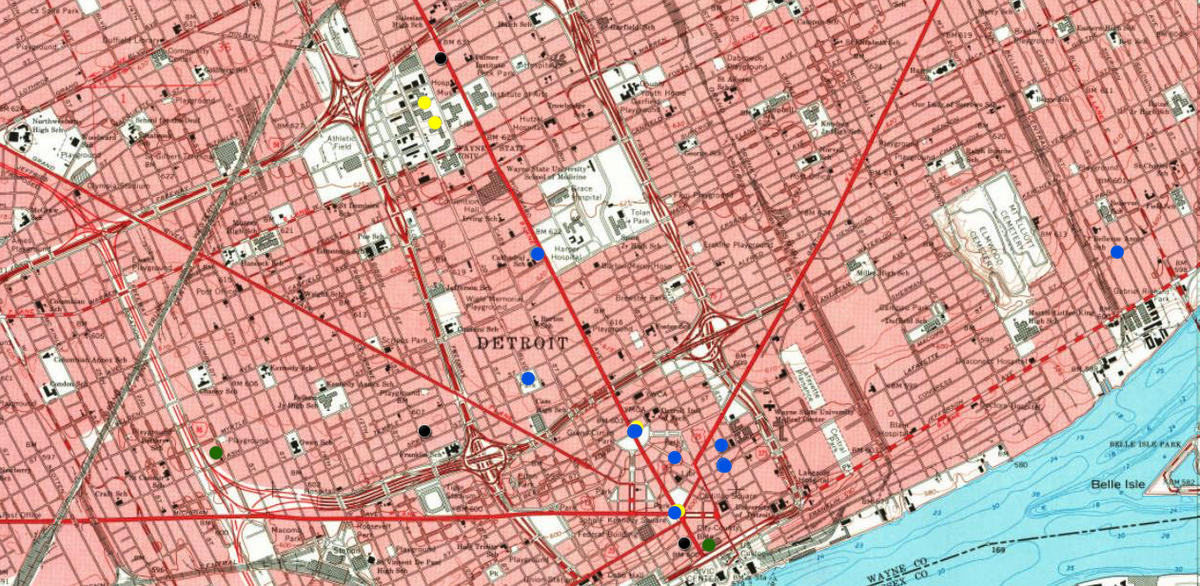Political Surveillance
The DPD's Criminal Intelligence Bureau conducted systematic, secret, and illegal surveillance on thousands of political activists and dozens of political organizations in the city of Detroit during the late 1960s and early 1970s. The Criminal Intelligence Bureau, as indicated in the DPD's annual report for 1968, had a mission to "gather, record and investigate information concerning individuals or organizations whose background or association identify them with criminal activities" and to "investigate and compile data regarding subversive groups." The Criminal Intelligence Bureau coordinated its activities with other DPD units, in particular the Special Intelligence Unit, as well as the Special Investigation Unit of the Michigan State Police (MSP), in concert with the FBI's COINTELPRO program to "disrupt" and "neutralize" civil rights, black power, and New Left organizations. This multiagency surveillance of the constitutionally protected activities of political activists represented a massive abuse of power and violation of law, ostensibly justified through a slippery slope rationale that "subversive" groups advocated violence to achive their political aims and sought to overthrow the government and its law enforcement agencies.
The DPD's spying operations targeted activists and organizations on the left and represented yet another way in which law enforcement in Detroit operated as a right-wing political movement. When publicly exposed in the mid-1970s, the DPD's political surveillance program had compiled secret information on more than 1.4 million people since its establishment as the so-called "Red Squad" in the 1940s, with a mission to investigate alleged communists and socialists in the labor and civil rights movements (right). The Michigan State Police's Special Investigation Unit, which also operated in secret and without legislative oversight, had created files on more than 50,000 "subversives" across the state by the early 1970s and worked particularly closely with its counterparts in the DPD. Both agencies made their files available to the counter-intelligence units of the Federal Bureau of Investigation, and vice versa. Overall the DPD and MSP's combined efforts resulted in specific dossiers on somewhere between 100,000 and 150,000 people--individually targeted "subversives"--in the state of Michigan by the early 1970s, with the majority based in the city of Detroit.
Black activists in Detroit began to get a clearer sense of the formal existence of the DPD's political surveillance operation in the late 1960s after police officials involved in the program testified about "subversive" activities during U.S. congressional hearings conducted by right-wing politicians, especially one focused on the League of Revolutionary Black Workers (right). The DPD's illegal disruption campaign against the Black Panther Party also alerted activist groups to the activities of police spies and undercover informants. In 1971, a coalition of black activists led by Coleman Young and Kenneth Cockrel, the attorney for the League of Revolutionary Black Workers, petitioned the Detroit City Council to abolish the DPD's Criminal Intelligence Bureau. Coleman Young argued that DPD officers should be "back on the streets to fight crime" rather than harassing political activists engaged in constitutionally protected activities. Additional support for the petition came from the NAACP, Congressman John Conyers, the Interfaith Action Council, and the New Detroit Committee. The Guardians of Michigan, an association of African American police officers, joined the coalition and declared that the DPD must change "from oppressor to defender of the oppressed." The coalition categorized the DPD's surveillance program as another "illegitmate intrusion of the police into the political sphere."
The scope of the DPD and MSP political surveillance operations only began coming to light in 1974, after radical activists started exposing the programs through investigatins and a series of lawsuits that stretched into the 1980s. Law enforcement agencies immediately sought to destroy the records of their historical activities, to prevent public exposure. The litigation resulted in a settlement that prevented record destruction but also kept the files confidential, unless individuals requested their personal files and chose to make them public. Ostensibly, this policy serves to protect the privacy of people placed under state surveillance, but is also has functioned to obscure the scale and many of the specifics of the illegal police state activities of the DPD and MSP's counter-intelligence operations. Only a small part of this massive abuse of power can be formally documented, and like so many other aspects of the deliberately hidden archival silences surrounding police brutality and misconduct in Detroit, much of this history may never become public.
The DPD and MSP surveillance operations targeted civil rights, black power, and radical labor organizations. Although allegedly justified based on these groups' potential to commit violence, the operations systematically surveilled groups that were committed to nonviolent protests as well as more militant direct-action and self-defense organizations. While the DPD's Criminal Intelligence Bureau occasionally also surveilled right-wing vigilante organizations, such as the white supremacist group Breakthrough, the overriding focus was on the political left. Undercover police officers and police informants attended the meetings and protests of political organizations, placed their headquarters under surveillance, infiltrated their membership and when possible their leadership with agent provocateurs, and gathered detailed demographic information and often automobile license plates of everyone who attended political gatherings. It is clear that street-level police units then used this information to criminalize political activists on trumped-up charges, as with the constant traffic stops and loitering tickets for members of the ACME/AAYM anti-police brutality movement in the mid-1960s, which was also infiltrated by agents working for the DPD and FBI. Kenneth Cockrel, an attorney and leading black power activist in Detroit by the mid-1960s, had received 83 discretionary traffic citations as a formal target of police harassment, as noted in a joint MSP/DPD report on his "subversive" political activities compiled in 1971.
The illegal political surveillance by the DPD and MSP escalated rather than thwarted violence. Case studies in this exhibit document the links between undercover infiltration, political surveillance, and preemptive DPD violence in the Kercheval Incident of 1966, the New Bethel Incident of 1969, and the campaign against the Black Panther Party of Detroit during 1969-1970. The DPD and MSP also systematically surveilled anti-Vietnam War organizations and protests, which linked black power activists and the white students in the New Left, as well as everyone involved in anti-police brutality campaigns, including the Ad-Hoc Action Group that Sheila Murphy started in the spring of 1968. It is safe to say that, even though archival evidence of these secret law enforcement operations is often deliberately buried, the DPD and the MSP conducted illegal political surveillance on almost every civil rights, black power, and white New Left leader and organization that appears anywhere in this Detroit Under Fire exhibit and many more who do not and were active in other political campaigns in the city between the 1950s and the 1970s.
The Tip of the Iceberg: Mapping the Political Surveillance of Sheila Murphy and Ken Cockrel
The files documenting the secret and illegal political surveillance of Kenneth Cockrel and Sheila Murphy provide a revealing window into the much broader patterns of the operations conducted by the DPD's Criminal Intelligence Bureau and the Michigan State Police's Special Investigation Unit. Ken Cockrel was a radical African American attorney and black power leader who, among many other activities, represented the Republic of New Africa defendants in the New Bethel trials and played a leading role in the campaign to abolish the DPD's violent STRESS unit that killed 22 people between 1971 and 1973. Sheila Murphy was a radical white activist who founded the anti-police brutality Ad-Hoc Action Group in the spring of 1968 and also played a leading role in the anti-STRESS campaign. Both of them were also very involved in the anti-Vietnam War movement and in a broad range of other political causes and organizations, as their police surveillance files document.
The surveillance records documented in the map below are available because Kenneth Cockrel and Sheila Murphy Cockrel, who married in 1978, obtained the DPD and MSP files that mentioned their names under the procedures established after the exposure of these operations and then donated them as part of their joint personal papers held by the Walter P. Reuther Library's Archive of Labor and Urban Affairs at Wayne State University. Access to these records is restricted for privacy reasons, because the files also mention the names of hundreds of other individuals in addition to Kenneth Cockrel and Sheila Murphy Cockrel, and researchers are not allowed to quote from the documents or to publish names of specific individuals.
The interactive map below is a data visualization of 32 confidential DPD and MSP records in this archive and documents the surveillance of one or both of Kenneth Cockrel and Sheila Murphy Cockrel at 32 separate events, ranging from small strategy meetings to mass protests, between 1965 and 1973. The map reveals the systematic police surveillance of the anti-police brutality movement, namely the Ad-Hoc Action Group and various anti-STRESS organizations that Murphy and Cockrel led, as well as their extensive involvement in anti-Vietnam War protests and other radical activities. The map displays surveillance of more than 20 different political organizations and shows not only the systematic abues of power by law enforcement but also the extensive interaction between black and white radicals in Detroit's vibrant left-wing protest culture.
Click on the dots to read the incident descriptions of each event placed under surveillance, and zoom the map to view the high concentration of surveilled organizational meetings and protests in downtown Detroit, including in progressive churches, and in buildings on or near the campus of Wayne State University.
Map of 32 Files of DPD and MSP Surveillance of Kenneth Cockrel and Sheila Murphy, 1965-1973
- Black dots = Anti-Police Brutality Protests and Groups
- Brown dots = Anti-Vietnam War Protests and Groups
- Green dots = Black Power Groups
- Yellow dots = Economic Justice/Socialist Groups
- Red dots = Anti-STRESS Protests and Groups (STRESS was a DPD unit that killed 22 people between 1971 and 1973; more here)
The image below shows these incidents on a historical 1968 map of the city of Detroit. Click here to view an interactive version of this map, allowing exploration of these incidents in the specific churches, university buildings, and other aspects of Detroit's streetscape during this era.
Sources:
Box 2, Kenneth V. and Sheila M. Cockrel Collection, Walter P. Reuther Library, Archives of Labor and Urban Affairs, Wayne State University
Fifth Estate Collection, Labadie Special Collection, Hatcher Graduate Library, University of Michigan
"Extent of Subversion in the 'New Left,'" Part 9, Aug. 6, 1970, Subcommittee on Internal Security, Committee on the Judiciary, U.S. Senate (Washington: GPO, 1971)
Detroit News, May 4, 1971
Detroit Free Press, Sept. 28, 1974






